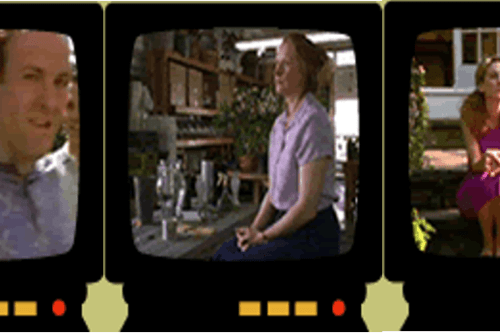Six Feet Under‘s central trope is the body—dead ones, reconstructed ones, sexual ones—which function as the vehicle through which to articulate a critical realism that challenges cultural and social normative codes. Critical realism is a mode of representation that Robin Nelson argues offers the most productive strategy for generating social change though TV drama. The particular power of critical realism lies in its ability to meet the affective desire in audiences for sense-making narrative frames while simultaneously offering alternative representations. 1 Thus, Nelson calls for TV drama that encourages “a critical disorientation of habitual ways of seeing” (171). It is my argument that Six Feet Under is a TV drama that offers the potential for “critical disorientation” mobilised through grotesque realism.
The program’s achievement lies in the excavation and examination of self and identity in contemporary culture enabling profound issues affecting daily life to be raised and explored. The Fisher family, around which the drama revolves, is described on the Home Box Office (HBO)’s Web site and in listing magazines as dysfunctional, but this is an erroneous description. The family members articulate the difficulties and complexities associated with life in contemporary culture, representing what John Ellis has described as a function of TV drama: that of “working through” cultural and social issues.
Uniquely situated within the funeral home, Six Feet Under is marked by its often risky subject matter. The activities of preparing a person for burial and the processes of grief that the Fisher family’s work facilitates provide the context for each episode in which boundaries governing what is sayable in TV drama are pushed and redefined. However, it is the matriarch of the Fisher family, Ruth, with her unruly behavior, that presents the central challenge to existing social and cultural norms: freed from the restrictions of the patriarchal family structure by her husband’s death in the first episode, her performance of the grotesque reveals the boundaries of propriety that govern the televisual and cultural representation of older female bodies. In addition, her performance opens up the possibility of change and renewal for members of her family.
As Germaine Greer points out in her book The Change, “There is no defined role for [fifty-year-old women] in society” (7). The “utter invisibility” (21) of middle-aged women identified by Greer is nicely challenged through the character of Ruth Fisher who presents us with a critical perspective within which the representation of older women opens up the chance of reconfiguring social and familial relations more generally. As a result of her husband’s death, Ruth’s performance is marked by a shift in the ways in which she experiences the world around her, and her own position within that world. The exploration of self that this engenders produces unruly (adventurous) behavior that stands in marked contrast to the buttoned-up, controlled, and conventional Ruth, underlining the degree to which she transgresses boundaries of decorum. And we know that Ruth ordinarily behaves herself because she is quietly spoken, wears drab, unflattering clothes, and spends a lot of time in the kitchen preparing food for her family.
Ruth is interesting for the following reasons: Her process of self-discovery is activated and enabled by the death of her husband, indicating some kind of release from the stifling restrictions of the patriarchal family structure and, represented as a dowdy, middle-aged woman (hair pulled back in a stringy bun), Ruth nevertheless transgresses the cultural and televisual norms that position women as sexually redundant once child-bearing years have passed. Ruth’s exploration of her sexuality and her representation as being sexually active constitute a risky performance, an activity that Mary Russo equates to stunting, in which “the discourse of risk-taking” introduces the grotesque body—freed from the restrictions of the self-sufficient, smooth, rounded, and closed “classical” body, in Bakhtin’s famous formulation—into a space that leaves room for chance and the creation of new meanings. Ruth’s behavior often stands counter to “models of progress, rationality, and liberation which disassociate themselves from their mistakes—noise, dissonance, or monstrosity” (11), and her stunts become increasingly risky as the seasons progress. Each opens up a space of possibility, even if that possibility is not fully realized: The fact, and then admission, of her affair with Hiram (discussed in more detail below); her near-lesbian relationship with Bettina, which includes a flirtation with drug taking and shop lifting; the attempts to draw the much younger and more-than-slightly-weird Arthur into an emotionally intimate and sexual relationship.
The pilot episode offers us the first glimpse of Ruth’s unruliness. During the viewing of Nathaniel Fisher’s body prior to burial, the muted, sedate, proper behavior of other mourners is threatened to be disrupted by Ruth’s sobs. On watching his mother being hurried out of the room, her son Nate asks his sister: “She’s sad so he has to take her out of sight?” Claire replies: “They always do that. The second someone starts to lose it they take them off into that room. Makes all the other people feel uncomfortable I guess.” This exchange underpins the way in which Ruth’s behavior breaches the restrictions of official life, which here results in David’s rather hurried attempt to contain, restrict, sanitise, and bury the “unseemly” behavior that is the primeval expression of grief. More than this, it serves as a comment on the ways in which uncomfortable, messy, and painful (and therefore embarrassing) emotions are managed within the wider, general context of contemporary Western culture.
- Nelson’s notion of critical realism stands in contrast to postmodern dramas such as Twin Peaks. Nelson argues that, despite the critical potential that lies in Twin Peaks‘ refusal to center the subject and its subsequent recognition that identities are not fixed, the series’ inclination toward fun works to preclude social criticism. While viewers may be actively engaged in the playfulness of Twin Peaks they may not be freed from reactionary attitudes.[↑]



